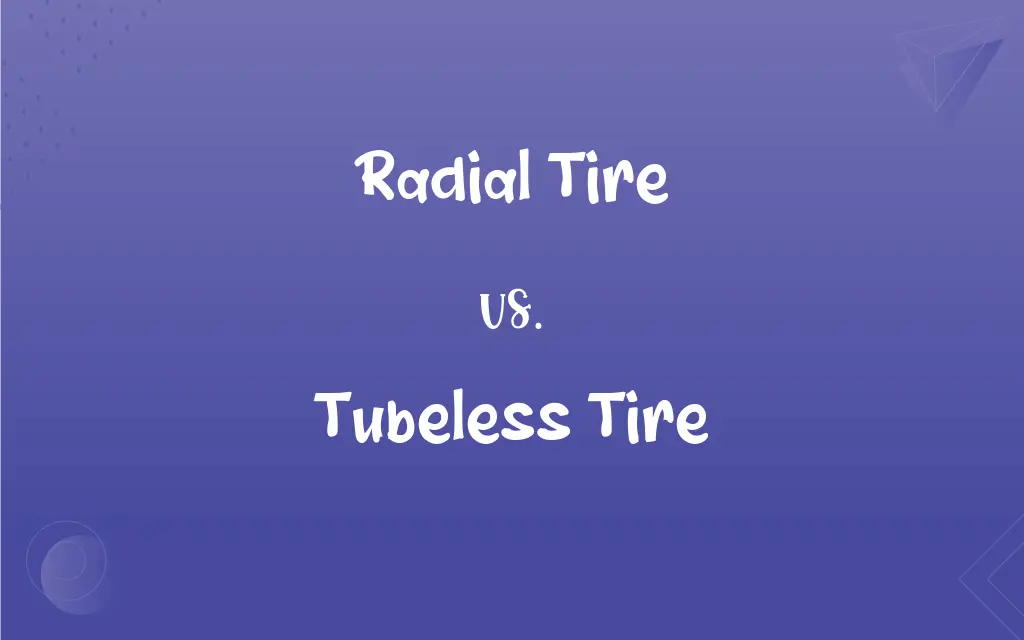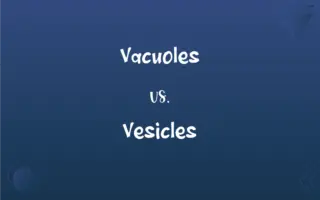Radial Tire vs. Tubeless Tire: What's the Difference?
Edited by Aimie Carlson || By Janet White || Published on January 31, 2024
Radial tires have perpendicular steel belts for stability and flexibility, while tubeless tires lack an inner tube, sealing air directly within the tire.

Key Differences
Radial tires feature a construction where the tire's body plies radiate outward from the center, providing improved strength and stability. Tubeless tires, on the other hand, are designed without an inner tube, holding air by forming an airtight seal with the wheel.
In radial tires, the steel belts under the tread offer better grip and heat dissipation, leading to longer tread life. Tubeless tires reduce the risk of sudden deflation and offer better puncture resistance, as they don't rely on an inner tube.
The flexibility of radial tires results in a smoother ride and better fuel efficiency due to reduced rolling resistance. Tubeless tires offer the advantage of running at lower pressures without the risk of pinch flats, common in tubed tires.
Radial tires are known for their durability and are commonly used in passenger vehicles for their high-speed stability. Tubeless tires, being airtight and not prone to inner tube damage, are increasingly popular in both cars and bikes.
Maintenance of radial tires involves regular pressure checks and alignment due to their structure. Tubeless tires, however, require less maintenance but need immediate attention in case of punctures to maintain the airtight seal.
ADVERTISEMENT
Comparison Chart
Construction
Body plies radiate outwards, with steel belts
No inner tube, air sealed within the tire itself
Puncture Resistance
Less resistant to punctures
Higher resistance, no risk of pinch flats
Ride Quality
Smoother ride, reduced rolling resistance
Can run at lower pressures, smoother on rough terrain
Maintenance
Requires regular alignment and pressure checks
Less maintenance, but punctures need immediate repair
Suitability
Preferred for high-speed and heavy vehicles
Ideal for a wide range of vehicles, including bikes
ADVERTISEMENT
Radial Tire and Tubeless Tire Definitions
Radial Tire
A radial tire combines radial ply construction with steel belting.
Radial tires provide better heat dissipation during long drives.
Tubeless Tire
A tubeless tire can maintain air pressure even after a puncture.
I prefer tubeless tires for their ability to handle minor punctures.
Radial Tire
A radial tire is constructed with layers of fabric cords radiating from the center.
The new car comes equipped with radial tires for enhanced stability.
Tubeless Tire
A tubeless tire forms an airtight seal with the rim, eliminating the need for tubes.
The new SUV uses tubeless tires for better off-road performance.
Radial Tire
Radial tires are designed for high-speed stability and durability.
Most modern vehicles are fitted with radial tires for better performance.
Tubeless Tire
Tubeless tires offer enhanced puncture resistance and safety.
The tubeless tires on her car prevented a blowout during the road trip.
Radial Tire
Radial tires feature perpendicular steel belts for increased grip and tire life.
Upgrading to radial tires improved my car's fuel efficiency.
Tubeless Tire
A tubeless tire is designed without an inner tube, sealing air inside the tire.
His mountain bike's tubeless tires provide better traction on trails.
Radial Tire
A radial tire is characterized by its flexible sidewalls and stable tread.
Radial tires offer a smoother ride compared to traditional bias-ply tires.
Tubeless Tire
Tubeless tires provide a smoother ride by running at lower air pressures.
Switching to tubeless tires improved my vehicle's handling on rough roads.
FAQs
What is a tubeless tire?
A tire that operates without an inner tube, sealing air inside itself.
What is a radial tire?
A tire with radial ply construction and steel belting for durability.
How do radial tires enhance vehicle performance?
They offer better grip, fuel efficiency, and high-speed stability.
Are tubeless tires suitable for all vehicles?
They are increasingly common in cars and bikes but check compatibility.
What are the advantages of tubeless tires?
Better puncture resistance, safety, and the ability to run at lower pressures.
Can radial tires fit on any vehicle?
Generally yes, but compatibility depends on the vehicle's specifications.
How does the radial construction affect tire life?
It improves tire life due to better heat dissipation and reduced wear.
Are radial tires more expensive than traditional tires?
They may be slightly more expensive but offer better value in the long run.
Do tubeless tires require special rims?
Yes, they require compatible rims to form an airtight seal.
What happens when a tubeless tire is punctured?
It may lose air more slowly than a tubed tire, allowing for safer, controlled stops.
Can radial tires be repaired easily?
Yes, they can be repaired like regular tires unless the sidewall is damaged.
What pressure should radial tires be kept at?
Follow the manufacturer's recommended tire pressure guidelines.
Can radial tires be used off-road?
Yes, but specific off-road radial tires are recommended for rough terrain.
How do radial tires affect driving in wet conditions?
They offer better water dispersion and grip in wet conditions.
Can tubeless tires be used with tubes?
Yes, but it defeats the purpose of having tubeless tires.
How long do tubeless tires last?
Their lifespan is comparable to regular tires, depending on use and maintenance.
Can I convert my existing tires to tubeless?
It depends on the tire and rim compatibility; consult a tire expert.
Are tubeless tires easier to maintain?
They require less maintenance but should be checked regularly for punctures.
How do I fix a punctured tubeless tire?
Temporary repairs can be made with a plug kit, but professional repair is recommended.
Is radial tire technology better for the environment?
It can be, due to better fuel efficiency and longer life.
About Author
Written by
Janet WhiteJanet White has been an esteemed writer and blogger for Difference Wiki. Holding a Master's degree in Science and Medical Journalism from the prestigious Boston University, she has consistently demonstrated her expertise and passion for her field. When she's not immersed in her work, Janet relishes her time exercising, delving into a good book, and cherishing moments with friends and family.
Edited by
Aimie CarlsonAimie Carlson, holding a master's degree in English literature, is a fervent English language enthusiast. She lends her writing talents to Difference Wiki, a prominent website that specializes in comparisons, offering readers insightful analyses that both captivate and inform.































































